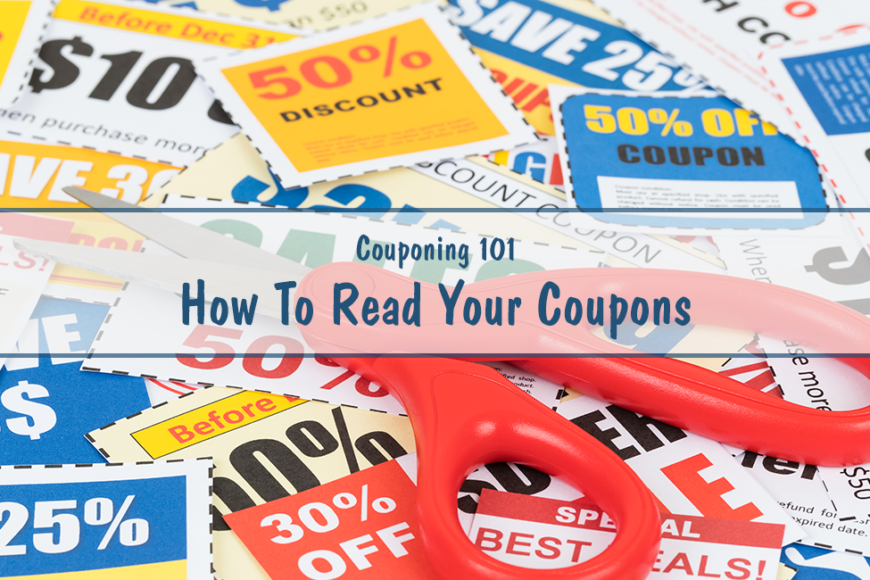
Anatomy of a Coupon: How to Read Coupons
I don’t know about you, but the biggest hurdle I had when I first started using coupons was the uncertainty that came with it. Am I using it right? What if the cashier rejects it?
One of the best ways to defend against this uncertainty is knowing how to read your coupons. Understanding how your coupons work will empower you with knowledge and confidence so that you can be a better couponer!
So let’s talk about the different components of coupons:
Expiration Date
Where is it? All coupons have an expiration date located somewhere in the fine print, which is usually printed along the bottom or on the back of the coupon. Even if a coupon doesn’t expire, it will actually say, “No expiration date” so you can be sure. If you’re printing a coupon online, be sure to print all of the pages or sides that are available so you don’t accidentally miss the fine print!
What time is it good til? The expiration date usually won’t have a time printed on it, but generally you can use the coupon until 11:59pm local time (or when the store closes) on the day of the expiration date.
What if the coupon is expired? While most stores will refuse an expired coupon, it never hurts to ask at checkout if they can honor it. Pairing the request with a really nice attitude helps! The worst that can happen is they’ll say no, and you can either pay full price or put the product back. However, I do not recommend raising a stink about it if they refuse it. Just politely say, “Thanks anyway!” and move on.
Wording
This is the most important part of the coupon. The meat of the thing, as they say. This is what tells you how much will be deducted from your purchase and what you have to do to make that happen. It will specify either the dollar amount that you’ll save or the product(s) you’re entitled to if you meet the requirements.
For example, if it says “Save $1 on 2 Boxes of Cheerios” then you will save $1 total on your purchase if you ring up 2 boxes of Cheerios. You will not be able to redeem this coupon if you only put one box in your shopping cart.
On the flip side, if you get a coupon that says something like, “Save $5 on ANY $10 purchase,” you’ll be able to redeem that with a qualifying $10 purchase of anything (as long as it’s not excluded in the fine print, more on that below). Some people get tricked into thinking they can only redeem these by buying what’s pictured on the coupon, but that’s simply not true!
Picture
The picture on the coupon can be useful if you have never heard of the product, or if you need help locating the item on the shelf. It also helps build product recognition and is a great form of advertising for the manufacturer.
However, the picture is NOT what is important. The manufacturer will generally put the newest or most expensive product in the picture, obviously hoping you will think that’s the only qualifying purchase and buy that product. As long as you follow what is in the wording of the coupon, you can usually redeem the coupon by buying a lower-priced product, which is generally going to be the better deal.
Fine Print
The fine print is usually information meant for the retailer, like where to send the coupons for redemption. But, there are usually one or two lines that are intended for the consumer.
Manufacturers typically make the fine print small so that you’ll miss it and try to buy an item that you think is valid for the coupon but is not. Since you’ve already made it that far, the manufacturer is counting on you buying it regardless of whether the coupon actually works. Reading the fine print will also help to eliminate the risk of an awkward encounter at checkout, so make sure you read it!
In addition to the expiration date, the fine print often tells you the restrictions of a coupon. That being said, some cashiers may not fully understand the fine print. This can lead them to refuse a coupon that your purchase actually qualifies for.
Here are brief explanations of some common fine print phrases so you can confidently explain them if you’re ever in that position:
- Limit one coupon per purchase. Each qualifying item(s) is a purchase. If the coupon is for “Save $1 on 2 Boxes of Cheerios” and you buy two boxes, that is one purchase. If you bought two more, that is another purchase and you can use another one of these coupons. You can’t, however, use two of these coupons on one purchase. For example, you would not be able to use two coupons on just two boxes and expect to save $2.
- Limit one coupon per transaction. This means you can only use one of each coupon per transaction. Each transaction is concluded with a receipt. One way around this is to ring things up in separate transactions so the cashier can scan the coupon multiple times, but a lot of stores look down on this and may tell you that’s not allowed.
- Limit one coupon per day/visit. You can only use one of those coupons per store visit in one day, but there’s nothing stopping you from coming back the next day to use it again!
- Limit one coupon per person/customer/household. This is the most restrictive phrase of them all. No matter how you slice it, you can only use this coupon once.
I hope this helps dispel any hesitation you have about using your coupons. I truly believe that the best way to feel confident about couponing is to know how to read your coupons!




66 Comments
Angel
Yes I had 2 coupons I printed out at coupons.com but Walmart told me that that had the same number what number on the coupon have to be different??
Karen
Some coupons restrict the use to just one time per coupon. The serial code on the coupon is what this is referring to. Different manufacturers have different rules, so this doesn’t mean that all Walmart coupons are limited to one use! Just read the fine print on each coupon to find out 🙂
Teress Roberts
I’m confused.. my coupon says says 1 coupon per shopping trip. Does this mean I can only use 1 per transaction? This is new to me. I thought I could use more.
Karen
Yes that typically means you can only use one coupon per transaction.
Kristin
Im a little confused! Im new to all of this and i guess the most confusion i have is the double and triple couponing! All of my coupons begin with “00”. I hope this isn’t a dumb question but does that mean they can not be doubled??
Jenifer
I looked through all my coupons to see what could be doubled. I’m confused because I see some coupons with the barcode shown above. Then other coupons do not have the barcode broken down ex: 5 1234… Some show a barcode that reads 0012345-6789123. Do these double?
pam
I got a coupon says, save $1 off on any four VO5 shampoo or conditioner. What do that mean?
Meagan
It means you must buy 4 items to get $1 off.
Sarah
I’m knew to couponing and this maybe a silly question, but if I have a coupon that says its a manufacturers coupon then says (available at Walmart or redeemable at Walmart) does that mean I can only use that coupon at Walmart?
Meagan
No, that’s a manufacturer’s coupon that you should be able to use at any store. 🙂
Nawtqt
I have a coupon from my dentist office that says, “$325 DENTURES PER ARCH regular price dentures starting at $325 per arch. Offer is valid for patients with or without insurance, is subject to changes and expires 12/31/12.” I am getting dentures, uppers now and bottoms in about six months or so. How does this coupon apply to me? Anyone know if it does? My uppers are more than $325.
Sierra Emery
Hi, I am new at this and trying to figure out the best way to start couponing. I purchased the sunday paper for the first time and found that there really are not that many coupons in it. but anyways my qeustion is I have a walgreens coupon for some pain releif pills $4.00 off and the coupon reads limit 3. does that mean I can use three coupons on one product or three total on three different products?
Meagan
Hi Sierra. Is the coupon found in one of the Walgreens coupon books? Or in-ad coupon? Usually the way Walgreens coupons work is that when you scan the coupon once at the register, it takes the value off of all the products you buy. So in this case, if you have a coupon for $4 of the purchase of 1 pain relief pills, and there’s a limit of 3, you can buy 3 products. When you scan the Walgreens coupon, it will take $4 off each pain relief product you buy. So $12 total will come off you bill. Since it’s a limit of 3, the coupon will only work for a max of 3 items. Make sense? 🙂 I hope that helps!
Dale Lyons
In your search for coupon information have you run across any standards for coupon widths? Working on a project that requires information on coupons.
Thanks, Dale.
Cassie
I have a ? On how to read a coupon. Ok the coupon says limit one coupon per person. No more than 4 coupons (of any kind) for the same product in the same transaction. What does this mean??
Stephanie
It says per person? If it does then that is what you must follow. If you mean per purchase, then it means you can only use one coupon per purchase (each item, or set of items you buy is a purchase) and only 4 of that coupon in a transaction. So if you have 5 coupons for $1 off 2 Kraft cheese products, at most you can buy 8 Kraft cheese products and use 4 of the $1 off 2 coupons.
Mary
I am new to couponing and trying to understand the wording. For example I have a coupon that states “Save .50 on any four cans of Chef Boyardee”. Does that mean that I save .50 off each can or is it .50 off the total purchase of four cans. The small print says “Limit one coupon per purchase”.
Thanks for your help.
Stephanie
It’s 50¢ off total, not per can.
amy
What if it says limit 4 or limit 2 deals
maria
Hi my question is if i have 1 manufacture come that came in the newspaper insert like for an example a kellogg’s coupon $1/3 an i go to print a $1/3 on one of the coupons websites can i use both in one transaction or purchase?.thank you
Stephanie
No, you can only use 1 coupon per item (in this case, the $1/3 coupon applies to all 3 cereals) regardless of whether the coupon came from the newspaper or online.
Pearl
So is there a $ limit on the coupons that double?
Stephanie
Each store is different. Stores in my area will only double coupons that are $0.50 and under. In some areas, the stores will double coupons that are $1 and under.
manali
wow! it’s a great .
I want to know can damaged coupon read?
Stephanie
It just depends on how badly it’s damaged.
Alma
Hi I’m fairly new at the couponing stuff i’ve gone shopping with them before i actually jst came back from a trip i have a question and i dont know who to ask? I know the whole 1 coupon per purchase and all that. BUT what does limit of 4 like coupons in same shopping trip mean? is that only 4 of the same items in 1 trip or 4 of similar coupons on trip like P&G coupons? i ONLY buy 4 of the same items since that is the amount of newspaper i get so can i use many p&G coupons in same shopping transaction? Hope you understand my question? sorry i feel dumb i’m just so new at this.
Stephanie
It means you can only use 4 of those same coupons per shopping trip. So if you have 5 coupons for $1/2 Pantene products, you could only use 4 of those at one time and save the 5th coupon for another time.
Will
About decoding a coupon.. I’ve been working on both a grocery/inventory app for my network at home.. but also a companion coupon code matching routine… the coupon codes are referenced against the official grocers assoc db.. I have found that some, not all mnfctrs word or state a required amount to purchase.. that is not the actual coded requirements.. i.e. A Campbell’s Soup coupon for buy 2 and get 40 cent off is coded to require only 2 items for the 40 off.. but A shopper wouldn’t really know because it would simply scan and take off the 40 cent [for the record in the last 3 weeks I have been double checking my coupons… 2 out of 5 campbell’s coupons are well.. getting Purchasers to buy more to offset coupon use…]
Anna
Hi ,
Just a question i like to ask about coupon i have (save 75 c ON ANY colgate sensitive pro relief toothbrush) it means that i have to buy the toothbrush or if it says ON ANY i can use this coupon for any other colgate product .
I thank you in advance.
Stephanie
If it says toothbrush – you have to buy the toothbrush. By “any” they mean any variety of the toothbrushes listed. It does not mean any colgate product.
laura balzekas
Hey, i was checking out the article because some of my coupons are confusing, and i was trying to figure out how to know if a product was included with the coupon before getting to the register. I didnt realize people even thought of cheating the system, thats just crazy!
Giovanna
I am confused. There are coupons that say “one coupon per purchase” and there are coupons that say “one coupon per purchased item”.
I have always thought that “one coupon per purchase” was another way of saying “one coupon per transaction”.
Now having seeing coupons that say “one coupon per purchase item”, helps be think that “one coupon per purchase” is not the same thing, rather confirms by belief that is another way of saying “one coupon per transaction”.
Christina S.
If you are purchasing 15 items and have 15 coupons that say one coupon per purchase, then you can use 15 coupons. If the coupon says one coupon per purchase per transaction or household, you can only use 1 per transaction.
Wendy
I really enjoy your site; I am preparing to begin couponing. It looks like your link to the Moms Need to Know site is broken. I guess they also thought better of posting that info.
Jennifer
I have a hard time understanding when the coupon says get $1.00 on ONE and sometimes it is written like (1). What’s the difference between the two?
Stephanie
There is no difference, they are just spelling it out and then writing the number.
Teresa
is it true that if you have a “buy product x and get product y for free” that you can then use another coupon on product x to reduce the cost of product x?
Stephanie
@Teresa, I do not believe that you should, but it’s a debate: https://www.couponing101.com/2010/05/stacking-b1g1-coupons-and-11-coupons.html
Kristen
OK, I’m really new to couponing and thought I understood the gist of the coupon rules until I looked at the fine print on some of the items I’ve seen in today’s ads (P&G specifically). Most of them say “Limit One Coupon Per Purchase of products and quantities stated”.
An example: I saw a coupon for $ off when purchasing deodorant, body wash, and something else together. I initially thought that I’d be able to use this coupon towards the something else and then apply a coupon for the deodorant to that and a coupon for the body wash to that–but now I’m confused. Help?
Also, I live in a part of the country where there aren’t store loyalty/discount cards (CVS is moving into the area but there isn’t one near me yet) so I envy the savings that many of you get from those avenues!
Stephanie
@Kristen, I posted about stacking coupons here: https://www.couponing101.com/2010/05/stacking-b1g1-coupons-and-11-coupons.html
shannon
This info was very helpful. Thank you.
elizebeth
i just know how to get started or that orginized!!! help
Stephanie
@elizebeth, Hi, you’ll want to check out the getting started section of my site: https://www.couponing101.com/getting-started
Emma
I saw the same show…$600+ worth of groceries for like under $4. Also kept thinking to myself….can they really use all that food before it goes bad?
Stephanie
@Emma, They probably can’t. 🙁 I think a stockpile is smart, but if you’re buying more than you will ever be able to eat then you’re wasting money.
Christina S.
My family of 13 could and does eat $600 worth of groceries before they go bad.
Sally
On extreme couponing the people are saving a lot of money by collecting the same coupon on that one product, but most only allow one coupon per purchase. So how do they save all this money if the are only allowed to use the coupon once?
Stephanie
@Sally, One coupon per purchase means you can only use 1 $1/2 coupon on 2 items. Or 1 $2/1 coupon on 1 item. Each item is a purchase. So, if you have 5 $2/1 coupons, you can buy 5 items and use all 5 coupons.
Molly
@Stephanie, okay I’m confused then because I’ve always been able to use two coupons per purchase. For example, I have 2 coupons for $1 off 2 boxes. each box is a purchase and gets a coupon attached to it so I get $2 off two boxes. Each box is a purchase so they get their own coupon. I’ve always done this and never had an issue.
Stephanie
@Molly, No, only 1 coupon can be applied to each item. So if you are using a $1 off 2 coupon then that coupon is applied to BOTH boxes. You cannot use another coupon on either of those boxes.
Molly
@stephanie, I’m really not trying to be rude but I swear to you I’m right. Google “one coupon per purchase” and you will see hundreds of pages agreeing with me. For example, if my shopping trip consisted of only those two boxes in your example, then that would be one coupon per transaction. If I used two coupons like I described, then that would be one coupon per purchase because you are purchasing items. I promise promise I’m right.
irene
i think if they are two seperate things like boxes of cereal and you get two dollar off coupons you could use one for each.. if coupon says 1 dollar off two boxes you can only use one am i right?
davem
Great article. I found the discount table helpful is there a similar table for the mfg id and family codes?
Thanks dave
Katie
Thank you for taking your time to post. I’ve stopped couponing for a bit but this has encouaged me to take it back up again with better knowledge. I have in the past made some mistakes and have always wondered why they took one stack of coupons and not another.
Any help for you to make my life simple is greatly appreciated.
Coupons
It’s an economical fact that the coupons save great deal for suffering families. We should encourage everyone to participate in this. I personally save hundreds of dollars a month..
Lori
This may be a different subject for you to cover, but I have always wondered how the store actually gets the money for the coupons from the manufacturer.
Stephanie
Erica,
I have seen a couple of those recently too and they are very strange. In that instance you would go with the household limit.
-Stephanie
Erica
Thanks for the information!! Do you know what: “Limit one coupon per purchase/household” means? Does that mean only one per household or one per purchase? I’ve never seen those 2 stipulations together – – it’s on this weeks Mazola Cooking Oil coupon.
Rachel @ Surviving The Stores
Great post, Steph!!
I’ve always thought that the manufacturers putting “Do Not Double/Triple” on the coupons was to protect their behind if the store for some reason doesn’t double or triple and the customer tries to blame it on the manufacturer.
I could totally be wrong, but that makes the most sense to me.
.-= Rachel @ Surviving The Stores´s last blog ..How To Get More Coupons! =-.
Stephanie
K,
99 coupons are much more complicated and many registers don’t support them. I’m not sure why coupons write do not double/triple in the first place since the store pays for the doubled amount, not the manufacturer, so it shouldn’t affect them in any way.
The 5 coupons will double/triple automatically regardless of the DND/T wording, unless the cashier manually inputs the coupon to avoid doubling.
-Stephanie
K
For the coupons that say “do not double/triple”, why don’t they put a “99” instead of a “5” on the Q? I have loads of Qs that say this but none have a “99” on them….?
….seems like a fairly easy thing for them to do?
K
Stephanie…
Whew! Thanks….I thought I was missing something 🙂
Rachel
Thank you K for asking that and thank you Stephanie for the update! I have heard of coupon decoding, but wasn’t sure exactly what it meant. NOT that I would use this information for anything other than its intended purpose, but I am glad I am armed with this knowledge so I can now stick up for myself (and my coupons) when the cashier questions me.
I have been turned down for the “per purchase” wording while trying to use several coupons for each corresponding product and the manager said I could only redeem ONE coupon. Instead of arguing, I said that I would take one item and let them put the rest back.
Amy
Wow, Steph! What a great (and thorough) post! I never knew any of this, and often wondered just how I was supposed to know if I was purchasing the correct item. Now I do! Thanks, and GREAT job!!!
.-= Amy´s last blog ..A Few Good Amazon Deals… =-.
Kimber
Wow, interesting! Thanks!
Val
Very useful and interesting information. Thanks!